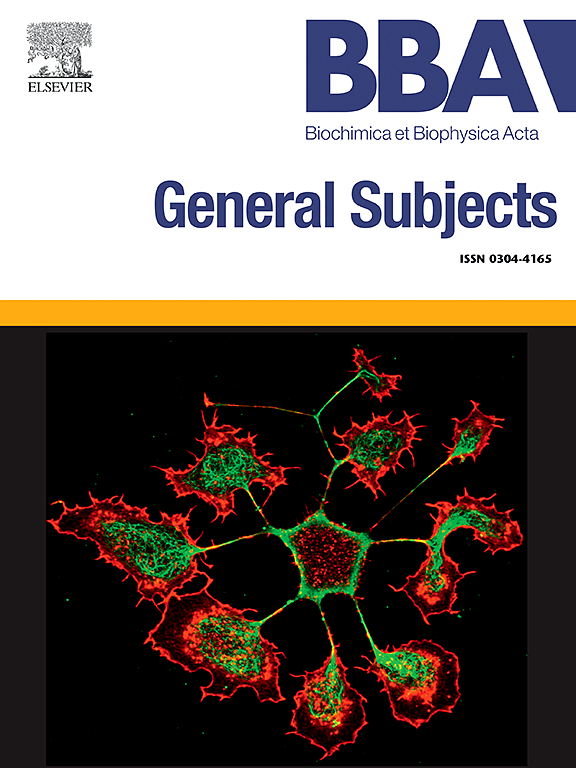The polyphenols phloretin and quercetin are potent horseradish peroxidase (HRP) inhibitors
IF 2.2
3区 生物学
Q3 BIOCHEMISTRY & MOLECULAR BIOLOGY
Biochimica et biophysica acta. General subjects
Pub Date : 2025-06-13
DOI:10.1016/j.bbagen.2025.130833
引用次数: 0
Abstract
The discovery of horseradish peroxidase (HRP) has been highly advantageous because its unique chemistry can be applied to diagnostic tools, including the detection of oxidative distress markers like hydrogen peroxide (H2O2) in various experimental systems. Here, we made the surprising and compelling finding that the flavonoids, phloretin and quercetin, which are usually described in the literature as potent antioxidants, strongly inhibit the activity of HRP. Using the amplex ultrared (AUR) assay, we discovered that phloretin at a concentration as low as 50 μM abolishes the detection of H2O2 production by isolated liver mitochondria oxidizing pyruvate and malate. Phloretin also nullified the detection of H2O2 produced by liver mitochondria oxidizing succinate or dihydroorotate. Moreover, phloretin at 100 μM completely abolished the direct detection of H2O2 by AUR and quenched the detection of purified xanthine oxidase (XO) activity, but did not interfere with dichlorodihydrofluorescein diacetate (H2-DCFDA) or dihydroethidine (DHE) fluorescent assays. Dose response assays revealed quercetin is a more potent inhibitor for HRP when compared to phloretin. Indeed, quercetin abolished resorufin fluorescence in AUR assays in the nM range whereas phloretin had no effect when detecting H2O2 in vitro or when it is formed by isolated liver mitochondria or cultured Huh-7 hepatoma and Mia-PaCa2 cells. Collectively, our findings demonstrate phloretin and quercetin, and potentially other polyphenols, potently interfere with HRP-dependent assays, which have strong implications for designing experiments that interrogate the antioxidant potential of flavonoids. Our results also indicate phloretin and quercetin could be applied as controls for HRP reporter assays.

多酚类根皮素和槲皮素是有效的辣根过氧化物酶(HRP)抑制剂。
辣根过氧化物酶(HRP)的发现是非常有利的,因为它独特的化学性质可以应用于诊断工具,包括在各种实验系统中检测氧化应激标志物,如过氧化氢(H2O2)。在这里,我们做出了令人惊讶和令人信服的发现,黄酮类化合物,根皮素和槲皮素,通常在文献中被描述为有效的抗氧化剂,强烈抑制HRP的活性。利用紫外红外(AUR)分析,我们发现低至50 μM的根皮素可以消除分离的肝脏线粒体氧化丙酮酸和苹果酸产生H2O2的检测。根皮素也使肝脏线粒体氧化琥珀酸盐或二氢乙酸盐产生的H2O2检测无效。此外,100 μM下的根皮素完全消除了AUR对H2O2的直接检测,猝灭了纯化黄嘌呤氧化酶(XO)活性的检测,但对二氯二氢荧光素(H2-DCFDA)或二氢乙胺(DHE)的荧光检测不产生干扰。剂量反应试验显示,槲皮素是一个更有效的抑制剂HRP时,与根皮素。事实上,槲皮素在nM范围内的AUR检测中消除了间苯二酚荧光,而根皮素在检测体外h2o2或分离的肝线粒体或培养的Huh-7肝癌和Mia-PaCa2细胞形成的h2o2时没有作用。总的来说,我们的研究结果表明,根皮素和槲皮素以及潜在的其他多酚类物质可能会干扰酶依赖性测定,这对设计黄酮类化合物抗氧化潜力的实验具有重要意义。我们的结果还表明,根皮素和槲皮素可以作为HRP报告检测的对照。
本文章由计算机程序翻译,如有差异,请以英文原文为准。
求助全文
约1分钟内获得全文
求助全文
来源期刊

Biochimica et biophysica acta. General subjects
生物-生化与分子生物学
CiteScore
6.40
自引率
0.00%
发文量
139
审稿时长
30 days
期刊介绍:
BBA General Subjects accepts for submission either original, hypothesis-driven studies or reviews covering subjects in biochemistry and biophysics that are considered to have general interest for a wide audience. Manuscripts with interdisciplinary approaches are especially encouraged.
 求助内容:
求助内容: 应助结果提醒方式:
应助结果提醒方式:


